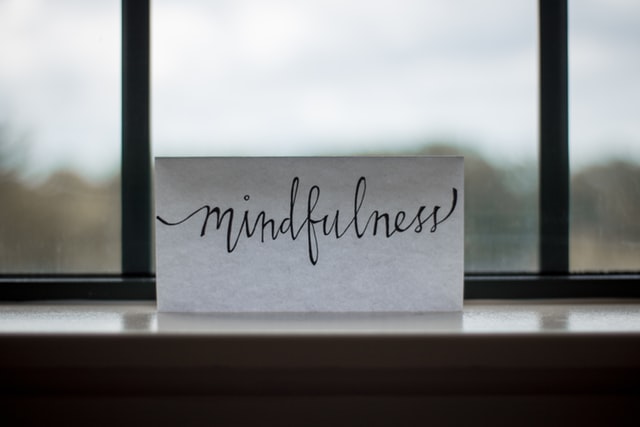I am personally in love with mindfulness practices. Mindful eating is a bit of a controversial topic in the eating disorder recovery field. Because, If you are not getting enough to eat it can be counterproductive to tell you to eat mindfully. (Imagine telling a starving person to eat slowly and mindfully!)
But in my own personal journey learning mindfulness practices helped me: heal from trauma and anxiety, find peace within myself, and be in the moment. All of which definitely helped my overall recovery and well being. You see, for me eating issues were not just food and body image issues. They were deeply rooted in family of origin issues and childhood trauma. While I needed to learn how to eat again, change my eating behaviors, and basically all my thinking around food, I also needed to heal from trauma, learn how to regulate my emotions and develop better coping skills.
So, here are my top 4 favorite Mindfulness Practices.
Use Your 5 Senses:
As you sit, name 5 things you can see, 4 things you can hear, 3 things you can touch, 2 things you can feel within your body, and 1 thing you can taste. This practice helps you get grounded in the here and now, especially if you are already feeling intense emotions.
Allow Feelings to Dissipate:
Did you know that the intensity of an emotion only lasts for about 2 minutes? That means that if you’re consciously putting your attention on the way a feeling presents within your body, it will naturally lessen or dissolve within 2 minutes. The trick is not to get your mind involved. The mind, and all the stories you tend to tell yourself about why you have an emotion, perpetuate emotions as long as you keep the story going. This practice helps you detach from the stories for a few minutes and gives the emotions a chance to dissipate on their own.
Sit quietly and identify the emotion by putting a name to it (i.e. “This is anxiety.) Then begin to describe to yourself where the feeling is in your body and what it feels like. This sounds like, “This anxiety feels like pressure in my forehead, squinching behind my eyes, tightness in my chest, butterflies in my stomach, a heaviness in my thighs, and tension in my feet.” Keep in mind that emotions will feel different for you. Anxiety may feel one way one time, and very different another. You may also feel multiple feelings at once. You’re a human after all, and that is perfectly normal. Just describe all the feelings you are experiencing.
After you have gone through your body head to toe like this a few times, usually at least 3 or 4, you’ll begin to notice a “lift” in the emotion. It’s palpable. Let’s say you started this process at a 9 out of 10 on a scale of difficult emotions. You may notice now that you are at a 5! The intensity of the sensations in your body just lifts. It doesn’t go away entirely, but it is now manageable. For me, this was one of the greatest discoveries of my life! Instead of being tossed around by my emotions, I learned how to cope with them successfully myself!
Observe a Leaf:
This mindfulness practice can be done with any object. I especially like objects from the natural world because they have more depth and intricacy to them. But, if you don’t have such an object available, anything will do. Sit and mindfully notice all the detail in this object. If you’re using a leaf, observe the colors, the outline, the edges, the veins, the change in color from top to bottom, the texture, the thickness, the layers. Notice anything you can about this leaf. If your mind wanders to other things, just gently pull yourself back to the experience of the leaf. Do this for at least 2 minutes. Notice how this practice makes you feel during and after.
Look Out a Window:
Take a few minutes just to notice the sights out a window close to you. I love to do this one at work between sessions to clear my mind and my energy for the next person I’m about to see. Instead of naming objects like “tree” or “grass” just observe them. Notice the light, the wind, the colors. Observe in the way that you might imagine a small baby sees the world, with no interpretations and no names for things just yet.
In mindfulness practices for coping skills, you begin to experience how it feels to live in the moment. Not concerned about the future or the past, your full awareness is now. It’s amazing how comforting that is! Unless a catastrophe is going on right now, the here and now is usually quite nice! I have found that most of the joy I have experienced in my life has come from this present moment awareness. Joy has space to bubble up from within when you are quiet and present in the moment.
Remember, mindfulness practices are just that–practices. There is no way to get them wrong and you’ll probably never get them perfect. They are so beneficial in recovery from eating issues that I am passionate about helping you learn how to use them. Just practice, and enjoy the process!


